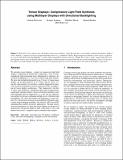| dc.contributor.author | Wetzstein, Gordon | |
| dc.contributor.author | Lanman, Douglas R. | |
| dc.contributor.author | Hirsch, Matthew Waggener | |
| dc.contributor.author | Raskar, Ramesh | |
| dc.date.accessioned | 2014-12-19T18:55:11Z | |
| dc.date.available | 2014-12-19T18:55:11Z | |
| dc.date.issued | 2012-07 | |
| dc.identifier.issn | 07300301 | |
| dc.identifier.uri | http://hdl.handle.net/1721.1/92408 | |
| dc.description.abstract | We introduce tensor displays: a family of compressive light field displays comprising all architectures employing a stack of time-multiplexed, light-attenuating layers illuminated by uniform or directional backlighting (i.e., any low-resolution light field emitter). We show that the light field emitted by an N-layer, M-frame tensor display can be represented by an Nth-order, rank-M tensor. Using this representation we introduce a unified optimization framework, based on nonnegative tensor factorization (NTF), encompassing all tensor display architectures. This framework is the first to allow joint multilayer, multiframe light field decompositions, significantly reducing artifacts observed with prior multilayer-only and multiframe-only decompositions; it is also the first optimization method for designs combining multiple layers with directional backlighting. We verify the benefits and limitations of tensor displays by constructing a prototype using modified LCD panels and a custom integral imaging backlight. Our efficient, GPU-based NTF implementation enables interactive applications. Through simulations and experiments we show that tensor displays reveal practical architectures with greater depths of field, wider fields of view, and thinner form factors, compared to prior automultiscopic displays. | en_US |
| dc.description.sponsorship | United States. Defense Advanced Research Projects Agency (DARPA SCENICC program) | en_US |
| dc.description.sponsorship | National Science Foundation (U.S.) (NSF Grant IIS-1116452) | en_US |
| dc.description.sponsorship | United States. Defense Advanced Research Projects Agency (DARPA MOSAIC program) | en_US |
| dc.description.sponsorship | United States. Defense Advanced Research Projects Agency (DARPA Young Faculty Award) | en_US |
| dc.description.sponsorship | Alfred P. Sloan Foundation (Fellowship) | en_US |
| dc.language.iso | en_US | |
| dc.publisher | Association for Computing Machinery | en_US |
| dc.relation.isversionof | http://dx.doi.org/10.1145/2185520.2185576 | en_US |
| dc.rights | Creative Commons Attribution-Noncommercial-Share Alike | en_US |
| dc.rights.uri | http://creativecommons.org/licenses/by-nc-sa/4.0/ | en_US |
| dc.source | MIT web domain | en_US |
| dc.title | Tensor displays: compressive light field synthesis using multilayer displays with directional backlighting | en_US |
| dc.type | Article | en_US |
| dc.identifier.citation | Wetzstein, Gordon, Douglas Lanman, Matthew Hirsch, and Ramesh Raskar. “Tensor Displays.” ACM Transactions on Graphics 31, no. 4 (July 1, 2012): 1–11. | en_US |
| dc.contributor.department | Massachusetts Institute of Technology. Media Laboratory | en_US |
| dc.contributor.department | Program in Media Arts and Sciences (Massachusetts Institute of Technology) | en_US |
| dc.contributor.mitauthor | Wetzstein, Gordon | en_US |
| dc.contributor.mitauthor | Lanman, Douglas R. | en_US |
| dc.contributor.mitauthor | Hirsch, Matthew Waggener | en_US |
| dc.contributor.mitauthor | Raskar, Ramesh | en_US |
| dc.relation.journal | ACM Transactions on Graphics | en_US |
| dc.eprint.version | Author's final manuscript | en_US |
| dc.type.uri | http://purl.org/eprint/type/ConferencePaper | en_US |
| eprint.status | http://purl.org/eprint/status/NonPeerReviewed | en_US |
| dspace.orderedauthors | Wetzstein, Gordon; Lanman, Douglas; Hirsch, Matthew; Raskar, Ramesh | en_US |
| dc.identifier.orcid | https://orcid.org/0000-0002-3254-3224 | |
| dspace.mitauthor.error | true | |
| mit.license | OPEN_ACCESS_POLICY | en_US |
| mit.metadata.status | Complete | |
